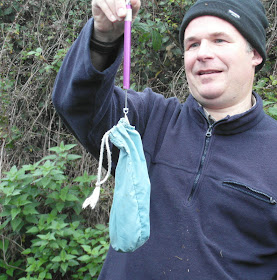Common shrew jawbones. The enamel at the very tips of the teeth is red.
Badger hair: white at the tip, ridged when you roll it between your fingers.
Weighing one of the mammals we trapped.
The Longworth traps are opened inside a bag so the animal doesn't leap away and escape.
Shrew in motion.
I think, going by tail length, we decided this was a pygmy shrew.
Bank vole.
Wood mouse. Scruffing small rodents is the best way to hold them; picking up a wood mouse by its tail can cause the skin to shear away painfully and permanently.
I was lucky enough to attend a Field Studies Centre course this autumn on mammal identification. The FSC run training courses for both amateur and professional ecologists, and cover a wide range of wildlife topics across their various schools: http://www.field-studies-council.org/ My course was at Preston Montford in Shropshire.
We were taught to prepare and set small-mammal traps, the correct way to check them and the proper way to handle and record the wild rodents we caught. We were also shown how to clean the traps after use. We looked at animal prints, nests, skin markings, scat, skulls and feeding signs, and listened to some common mammal calls. We looked at recording and reporting methods; we dissected owl pellets. At the end of the three-day residential course, students were invited to take an exam in Mammal Identification.
I'm delighted to say my certificate came this week and I got a Distinction, with 60 marks out of a maximum 64. So I'm very pleased because I enjoyed the course so much. Now I'm off to join the Mammal Society! http://www.mammal.org.uk/








I did one at Preston Mountford last year having heard about it through the Mammal Society.
ReplyDeleteI returned to cycling five years ago and in the first few weeks saw stoats running along the lanes because they weren't aware I was there. Then I noticed 'runs' in the grass banks and thought it would be nice to know whose they were, and then I discovered your blog that has been a delight to follow.
Thank you.
PS the hedgehog lady (Cheslyn Hay) doesn't return phone calls and doesn't have a donation button on her site that I could find.
I've barely ever seen a stoat, so well done. They're beautiful creatures. I love courses that teach you to look at the landscape in new ways - it's like cracking a secret code.
ReplyDeleteThanks for the kind words about my blog. x
hi Kate, love your blog lots of good information. I wondered if you could help me. I look after a garden in Burrington somerset. it has a large liner pond with pump powered stone waterfall. The sides of the pond has dry stone ledges with plenty of vegetation.We lowered the waterlevel to sort the lights and i found among the rocks collections of water snail shells all with the mid section broken and the bodies gone. also thier are scratch marks in the dried mud on the liner. I was puzzled untill i read your comments about voles eating snails. Is it possiable that this is water voles. The deposits of shells are all under water, would bank voles do this as well. The garden adjorns woodland but thier is no other waterways within a mile plenty of ditches and springs in the hills though. We have plenty of grass snakes including a very large one who frequents several of my gardens along the road. I havent found the droppings vegetation in the garden is nibbled especially the ornamental grasses but i guess any of the voles would do this.
ReplyDeleteIn another of my gardens i have dormice and was lucky another to find a summer nest in the top of a clipped box hedge. fortunately before i cut it as it was occupied. The dormice love eating the centre of the herbaceous geraniums when they wake up then. I forgive them !.
Thanks look forward to your insight.
Helen Johnson.
Gosh, how wonderful! That must be some garden. Do you arrange it specially for wildlife? Does your local Wildlife Trust know about the snakes and the dormice? Re the snail shells, it could be field voles or even rats if the shells have been delicately nibbled round the outside, but you say it's the insides that have gone. I think then then the possibilities are much broader and include some birds as well as bigger mammals. In the spring have a look for other signs, especially droppings, because that will soon tell you what you have living round your pond. Or ask your local WT to come out and check for you. Meanwhile I'll do a bit of research myself. Many thanks for your kind comments about the blog.
ReplyDelete